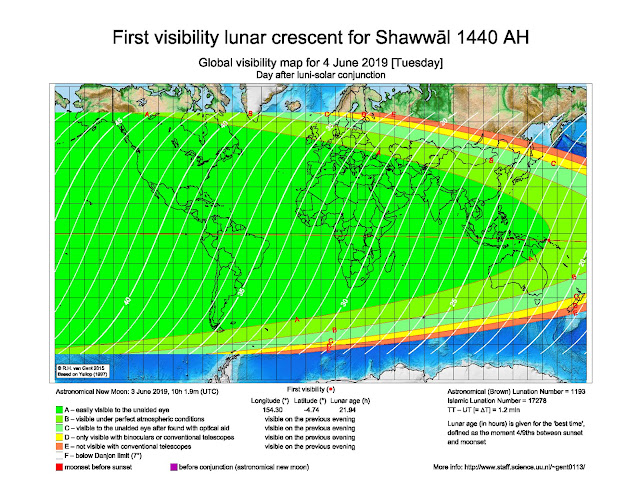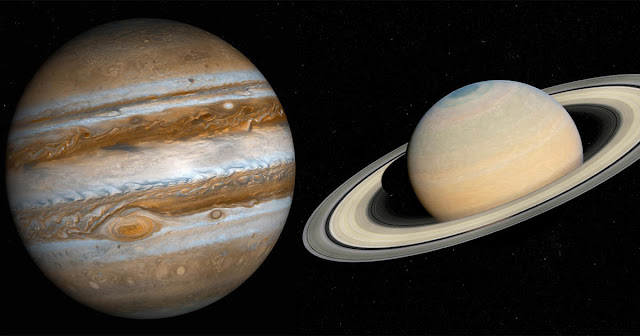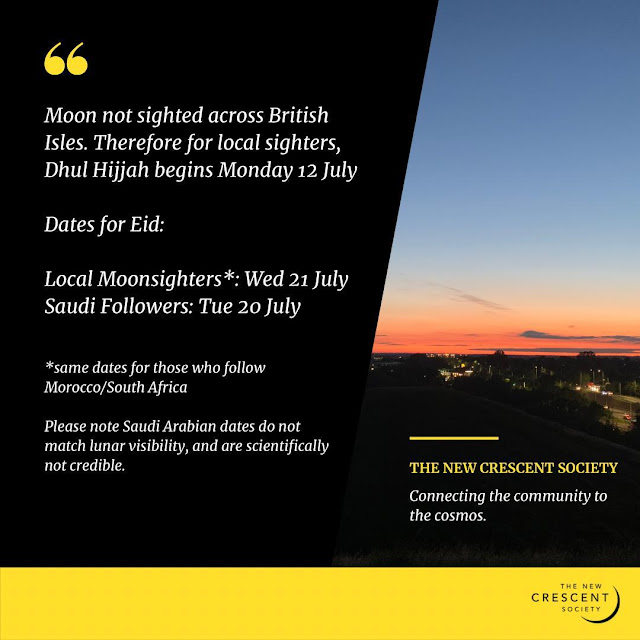When is Eid al Fitr 2019 / 1440 ?
Salam everyone!
We've been asked multiple times - when is Eid? And will we all be celebrating Eid on the same day?
We've written a blog to answer the question. Don't hesitate to comment below with your feedback or further questions!
**
Muslims across the UK started Ramadan 1440 on separate dates.
Broadly speaking, there are two different positions on moonsighting in the UK, which led to these different dates. They are as follows:
- Local Moonsighters: Started fasting on Tuesday 7 May 2019
- Saudi Followers: Started fasting on Monday 6 May 2019
If we started Ramadan on different dates, the question then arises - will we end Ramadan and celebrate Eid al Fitr on different dates?
The New Crescent Society predicts that we will all celebrate Eid on the same day in the UK: Wednesday 5 June.
Why are we making this prediction?
To understand why we think both groups will celebrate on Wednesday 5 June, let us examine each of the two groups in turn.
Why Local Moonsighters will start Eid on Wednesday 5 June
On 29 Ramadan, it is the Muslim tradition to go out and sight the New Crescent that marks the beginning of Eid.
For local moonsighters, Ramadan began on Tuesday 7 May.
Thus, 29 Ramadan will fall on Tuesday 4 June.
On 29 Ramadan / Tuesday 4 June:
Thus, 29 Ramadan will fall on Tuesday 4 June.
On 29 Ramadan / Tuesday 4 June:
- If the new crescent is sighted, Eid will begin on the next day, Wednesday 5 June
- If the new crescent is not sighted, Eid will begin on Thursday 6 June
The New Crescent Society predicts that the moon will be visible on Tuesday 4 June. Let's look at the data to explain why:
Below is a map demonstrating lunar visibility on 29 Ramadan / Tuesday 4 June.
This map is a lunar visibility map, and uses data about the position of the moon to accurately predict if the moon will be visible on any given place in the world.
The green zones on the map represent where the moon is visible to the naked eye.
 |
| Data for this map from HMNAO (Her Majesty's Nautical Almanac Office); map produced by University of Utrecht |
As you can see, the moon should be easily visible in the UK on Tuesday 4 June to the naked eye, as well as Europe, Africa, the Middle East, and most of Asia.
Therefore, the month of Shawwal will begin, and local sighters will celebrate Eid on Wednesday 5 June.
Why Saudi Followers will probably start Eid on Wednesday 5 June
This one is slightly more complex.
As Saudi Arabia started Ramadan one day earlier than local sighters, their 29 Ramadan will also be one day earlier. Therefore, they will attempt to sight the moon a day earlier - Monday 3 June.
In Saudi Arabia, on Monday 3 June (corresponding to 29 Ramadan in Saudi Arabia):
- If the new crescent is reported to have been sighted then Eid will be on Tuesday 4 June.
- If the new crescent is not reported to have been sighted, then Eid will be on Wednesday 5 June.
The New Crescent Society predicts that the moon will not be visible on Saudi Arabia on Monday 3 June. To explain this, let's again look at the lunar visibility map for 3 June.
The green zone to the far left (West) of the map represents where the moon can be seen. As you can see on this map, the moon will not be visible anywhere in the inhabitable world, and certainly not in Saudi.
(For some more guidance on reading this map, scroll to the 'Notes' at the bottom of the page')
According to the data that we have, we can categorically say that the moon will not be credibly sighted in Saudi Arabia on Monday 3 June.
(For some more guidance on reading this map, scroll to the 'Notes' at the bottom of the page')
According to the data that we have, we can categorically say that the moon will not be credibly sighted in Saudi Arabia on Monday 3 June.
Following this logic, Saudi Arabia will complete 30 days for Ramadan and celebrate Eid on Wednesday 5 June, alongside local sighters in the UK. This would mean we are all celebrating on the same day in the UK.
However, things are never so simple!
Saudi Arabia have a history of producing inaccurate sighting reports. Is there a possibility that they may produce a false sighting report for this Eid, and end up celebrating a day earlier than local sighters?
The New Crescent Society predicts that Saudi probably won't produce a false sighting for some technical reasons - read below to find out why!
Saudi False Sightings
Saudi Arabia have a long history of producing early sighting reports, which astronomers have dismissed over the years as impossible. You can watch our video which explains an instance of this happening for Eid al Adha last year.
There are also several academic reports which have looked at Saudi crescent sighting reports over a period of more than 20 years, demonstrating historical inaccuracies and false sighting reports. Examples include Ayman Kordi's paper (2003), and Gadi's paper (2007) [NB: we can't find an accessible pdf online of Gadi's paper, but here is a video of him presenting his paper on false sighting reports from Saudi Arabia, in Arabic]
So how can we be so sure that Saudi Arabia won't produce a scientifically-impossible sighting report on Monday 3 June?
Why Saudi probably won't claim to see the moon on Monday 3 June
So, we know the moon is not scientifically possible to see in Saudi on Monday 3 June. Why do New Crescent Society think that they won't produce a false sighting this year?
Our reasoning comes after consultation with members of ICOP (International Crescent Observers Project) who have informed us that Saudi Arabia have the following internal rule for moonsightings:
- If the moon has an altitude of less than 1° after sunset at Makkah, then sighting reports of the moon will not be accepted.
This rule is confirmed in an internal communiqué written by Saudi astronomer Dr. Zaki Mostafa. Our friend from moonsighting.org.uk, Engineer Qamar Uddin, has contacted some astronomers in Saudi who have confirmed the existence of such a communiqué, and will share it when they dig it out! Insha allah, when we have it, we will post it here.
Again - we can easily work this out using data. The below image is taken from Her Majesty's Nautical Almanac Office (HMNAO), which is a UK government body which supports with astronomical data.
The below image gives us various bits of information about the position of the moon at Makkah on Monday 3 June (as well as Tuesday 4 June, though that is not of interest for us right now).
 |
| Source: Her Majesty's Nautical Almanac Office (HMNAO) |
If we read across the top line for Mon June 3, over to 'Alt' (meaning Moon Altitude at Sunset), we will see that the figure is given as '0°'.
This means that the moon at Makkah, at the point of sunset on Monday 3 June will be so low that we can consider it directly on the point of horizon, or even below the horizon. Because we have knowledge of this this internal communiqué, New Crescent Society do not think that Saudi will produce a scientifically impossible sighting report on this occasion.
Indeed, since this internal rule has been implemented from 2002 in Saudi Arabia, we do note that the moon has never since been 'sighted' in Saudi whilst being so low on the horizon.
Before 2002, however, 'sightings' of the moon below the horizon or before moon-birth (conjunction) have been reported by Saudi. Examples include Rajab 1421/2000 and Shaban 1422/2001, where claims of the moon being sighted occurred before moon birth / conjunction! Since 2002, false sightings still do occur, but it is a case of Saudi Arabia claiming to see a moon which is too thin/impossible to see, rather than claiming to see a moon which is below the horizon!
Therefore, we predict a non-sighting report from Saudi on Monday 3 June, and we all will celebrate Eid together here in the UK on Wednesday 5 June!
Let's see what happens .... !
Notes on the Visibility Map
Further helpful notes on reading the lunar visibility map for 3 June.
- The green zone on the far left (or West) of the map represents where the moon can be seen using naked eye.
- The amber zone on the left of the map (over the Pacific) represents where the moon could not be seen, even with a telescope
- The 'clear zone' i.e. with no curve over it on the map (Americas, Africa, Saudi Arabia) is below the 'Danjon limit'. This is the zone where scientists would say it is impossible to sight the moon, even with a telescope.
- The 'red' zone on the far right (or East) of the map is where the moon is below the horizon
- The 'purple' zone on the far right of the map (over Australia) is where the moon has not yet been 'born'; in other words, it has not yet completed its orbit from the last month and hasn't reached conjunction/new moon phase yet.
The map is produced by taking a range of different data sets, including angular separation of the moon and sun, altitude and age of moon, and computing it into a predicted visibility map.




Above comment should say "habitable world" not inhabitable world. Whilst you lay out a case of false sightings of the moon, please also recognise that it is not soley Saudi that makes the mistakes, plenty have been made by yourselves in regards to moon sightings. Generally people (followers) are sick of bickering by the various sunni mosque molvis to score points with their following. All mosques have a responsibility to unite muslims not divide. You're above explanation is not structured towards unity but division. Stop pointing fingers like little school children and grow up please!...Benefit all not just your own flock!
ReplyDeleteTo be fair to them, they have just laid out some facts and probabilities as they see them about Eid.
DeleteThis hardly constitues “bickering like children”.
Would you prefer they didn’t give facts?
Thanks for this article !
Hi,
ReplyDelete“Habitable” and “Inhabitable” are in fact synonyms. Much like “flammable” and “inflammable”.
Cheers
"Cheers "... who are you?
DeleteIt is the responsibility of Molvis, Masjid leaders and Astronomers to inform and educate the public about any errors made by any side in the argument. It is also important to note that unity has to be on what is correct according to Quran and Sunnah. All Masaajid have a responsibility to lead their Musallees on what is correct not just to unite for the sake of unity. We need to revive the sunnah (some Ulama say it is fard al kifaya) of trying to see the new crescent) so lets unite on this sunnah
ReplyDeleteMessage to Mohammed Ashraf. How dare you say that the New Cresent Society is causing division when it was you who caused division and switched to following Saudi Arabia even though they have a history of false sightings.
ReplyDeleteHave you forgotten the letter you wrote to Islam Channel in 2005 telling them to refrain from making declarations without verification?
Thanks to New Crescent Society for publishing this article. This article is very useful.
Sa. When you say won't produce a false sighting this year it implies that they are intentionally misleading the ummah in the moon sightings. This is part of the issue of division and I have seen it is always the moon sighting committee followers not respecting other view points and put down other scholars or are unwilling to be flexible at any other view point other than their own. It'snnever the other way. It's always one way traffic. They never try to force their view on others. This is a fiqhi masail and open to many views like other fiqhi masaails. If you don't believe that you are implying Saudi are intentionally misleading the ummah, then clarify that, the reason for this is whether moon sighting practices need updating etc. By not mentioning clarity in the article you leave it to the reader to make their assumptions.
ReplyDeleteIt is very disappointing when Ulama choose to bury their head in the sand not talk about this issue. Could Muhammad Ashraf please clarify what is the Sunnah regarding how a community should start and end the Islamic month? Being an aalim it would be good for you to educate us. Surely there can't be a grey area in this issue as it is factual and based on observations.
ReplyDeleteNew Crescent Society are tackling this matter that is dividing communities and families head on. If Ulama say that you should not go out and sight the moon and give credible evidence from the Qur'an and Sunnah then that would be good to see. Please Muhammad Ashraf if you could provide this and admit that what you were preaching just over a decade ago was wrong and misleading then it would be appreciated.
This is a factual blog with lots of useful information.
ReplyDeleteThere is nothing in it to cause "division" or offend anyone, unless someone obsessed with following Saudi Arabia, which is not in Qur'an or Hadith nor followed by Sahaba or Tabeen or any Imams of major Sunni Madhabs.
So, let us all put our differences aside and revive the Sunnah of Moon Sighting in the UK (and stop the Bidah of following Saudi UQC!).
See YouTube video on When is Eid? https://youtu.be/DiN9z8nfD8g
Cheers who says that?
ReplyDeleteYour prediction was just contradicted. Eid is on Tuesday against your prediction Saudi wind declare a fake sighting. Same as everything else posted in the discussion. It's all a prediction. Reality is contrary.
ReplyDeleteEveryone here talking about 'unity' and 'division' . Please, the Muslim Ummah is in shambles right now with Muslims burning in Palestine, Sri Lanka, India, Syria, various parts of Africa and also North America and the UK. You think a piece of rock floating in space is gonna solve anything? What if we have one Eid, we'll just find another aspect of our Deen to fight over. For example, 20 rakaats vs 8 rakaats. It never ends. Everyone, just do whatever you feel is right. Just as long as you don't promote or defend haram activities like our politicians do with the LGBTQ+.
ReplyDeleteThe sunnah is provided in hadees and every know about it. We must agree to lunar calendar just like we agreed to offer salah by watch and times calculation and many others like namaz on loud speaker etc . But unti such time there is ijmah in ummah best way is to follow the way described in hadees.
ReplyDeleteTurkey also celebrated Eid on 4th June. So are we also casting doubts on their ability to correctly do moon sightings?
ReplyDeletehttps://www.moonsighting.com/1440shw.html
https://www.dailysabah.com/turkey/2019/06/04/happy-eid-al-fitr-turkey-celebrates-bayram-with-messages-of-love-unity-and-hope
Like Saudi Arabia, did they also make mistake?
Turkey is closer to UK than Saudi Arabia so should we not rely on Turkish moon sighting if we don’t see the first moon in UK because of cloudy conditions?
Turkey do it according the birth of the moon. This is a fiqh issue thus the criteria is different. First seek knowledge then blindly follow any group.
DeleteTurkey follows Altitude >5°, elongation>8°
ReplyDeletefor the new moon to be seen by the naked eye. If these requirements are met, it will ensure that the crescent is not too thin and that it is visible.
The goal is not to sight the hilal, the goal is to know the beginning of the new month. Sighting of the hilal is just the method. We as an ummah have become fixated on the method and have neglected the goal, hence all the controversy.
ReplyDeleteOn monday 3rd June 2019 the new moon was born before maghrib and there is no doubt in that. Whether it was visible, therein lies the doubt.
Sighting the new moon with the naked eye was the only way in the past to mark the beginning of the month. We advanced to using telescopes and now we should simply advance to using calculations which are incontrovertible.
The hilal is just a marker for the beginning of the month. Just like no one nowadays goes out to verify the shar'ee signs for the beginning of salah as we rely on calculated timetables, we should no longer require to visibly sight the crescent. You can argue that the calculations are the witness or sighting for the crescent.
This would unify much of the muslim world and avoid controversy as you can't doubt scientific calculations. This would also make planning for Ramadan, Eid etc much easier in the western world at least where we would know years in advance the dates for Eid/Ramadan.
It's time the Muslim world just moved with the times and realise that we have better methods than that which was available in the past to achieve the same goal, ie marking the beginning of the months in this case.
Turkey is nearer to UK than Saudi Arabia so would it be advisable for us to not depend on Turkish moon locating in the event that we don't see the principal moon in UK in view of overcast conditions? https://pkgiftshop.com/product-category/gifts-by-occasions/ramzan-ul-mubark/
ReplyDelete